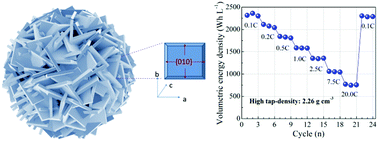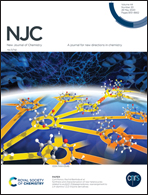Hierarchical Li-rich oxide microspheres assembled from {010} exposed primary grains for high-rate lithium-ion batteries
Abstract
Layered Li-rich oxides (LLOs) with high capacity exceeding 300 mA h g−1 and low cost are regarded as the most promising candidates for high energy-density (500 W h kg−1) lithium-ion batteries. However, they usually present sluggish Li+ kinetics and low tap-density, resulting in poor rate capability and volumetric energy density. Here, the wide particle size distribution of LLO microspheres assembled from {010} exposed primary grains is rationally proposed to solve the above-mentioned issues. A high specific capability of ∼295 mA h g−1 at 0.1C and superior cycling stability (capacity retention of 90.6% after 100 cycles) are achieved. The close stacking caused by the coexistence of large and small secondary particles gives rise to a high tap-density of 2.26 g cm−3, corresponding to a high volumetric energy density of above 2350 W h L−1. The TEM results confirm that the lateral direction nanosheets belong to the electrochemically active {010} planes, which further results in the improved Li+ kinetics during redox. As a result, an excellent high-rate capability of 110 mA h g−1 is achieved even at 20C. The GITT tests elucidate that the active {010} exposed planes exhibit superior Li+ diffusion kinetics during charge and discharge processes. This feasible strategy can be expanded to enhancing the Li+ kinetics of other NCM-based layered cathodes for alkali rechargeable batteries.



 Please wait while we load your content...
Please wait while we load your content...